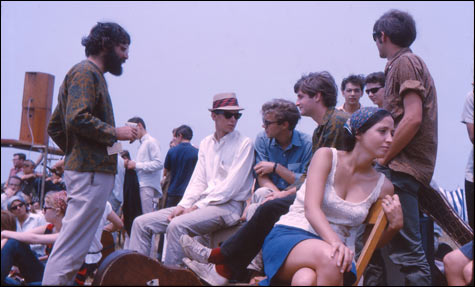
NEWPORT 1965: Joe (in the hat) with Eric Von Schmidt, Tom Rush, Geoff Muldaur, and Maria (Muldaur) d’Amato the year Joe plugged in Dylan’s guitar.
|
When I first met Joe Boyd, I knew him only as a legend, the force behind the psychedelic and folk-rock movements of the 1960s. I knew he had waded into the new scene, producing records for Billy Bragg and REM, but that didn’t explain his interest in an unknown North Carolina all-girl punk-folk-pop trio called blackgirls, my band.
I still don’t know how Joe found us. He just walked into our little den of punk-rock obscurity in a white linen suit. He was inscrutable, sitting on the floor of my almost empty apartment while we played our songs live because we didn’t have a demo tape to give him. It was as if Otto Preminger had wandered onto the set of a student film shoot.
The blackgirls were considered unpredictable, weird, and confrontational. On stage it seemed as if we could implode at any minute. Our guitar player, who wore tiny mini-skirts without any underwear and flashed the audience at intervals, considered self-mutilation a viable alternative to stage patter. I sulked behind my hair and cried dark things into the microphone.
For all our mouthy, modern defiance, Joe’s presence had a retrogressive effect on us. He was The Producer, and we became a girl group. We hid drug and drink problems from him. When our guitar player overdosed during mixing, we revived her, then hid her under the pool table at the studio and told Joe she had “allergies.” After reading his memoir White Bicycles: Making Music in the 1960s (Serpent’s Tail), I think now he would have understood, but at the time he seemed so grown up, and at 25 I was both scared and starstruck.
White Bicycles delivers an eyewitness report of the psychedelic era as dapper and self-assured as Joe himself. (He’ll reminisce at Club Passim April 4, where I’ll be joining him on stage along with the Silverleaf Gospel Singers.) Whoever doubted such a coherent account was possible is unacquainted with the kind of man who can both prep at Pomfret and plug in Dylan’s guitar at Newport in 1965, delivering a convulsive dose of electroshock therapy to American folk music. Although he admits he indulged moderately in drugs, perhaps it was this combination of the patrician and the puritanical that kept Joe from going off the rails when everyone around him was tweaking madly. But in his autobiography Joe is a believer in the redemptive might of music at a crucial cultural and political juncture. He quotes Plato by way of Ginsberg to describe the revolutionary potential of music in 1967: “when the mode of the music changes, the walls of the city shake.”
There was a time when a record producer was akin to a movie director. Material, artists, and artistic choices all funneled through the vision of the man (and it was always a man) behind the board. That’s old school. But Joe Boyd is old school. Mention his name and you invoke the era of the auteur producer, also his mind-boggling association with a who’s who: Pink Floyd, Eric Clapton, Nick Drake, Sandy Denny, the Incredible String Band, Fairport Convention, Steve Winwood, Richard and Linda Thompson, and more.
Joe’s first job in the music business was squiring tours of blues and jazz greats around Europe: Muddy Waters, Brownie McGhee, Sister Rosetta Tharpe, Coleman Hawkins, Roland Kirk. In between jaunts he stayed in London soaking up the diverse and open-minded atmosphere of the pop scene and the psychedelic underground. He fell in love with the great singers of British folk: the Watersons, Martin Carthy, Maddy Prior. The time was coming when there would be a convergence of all the music he loved — blues, rock, and folk from every imaginable province. Out of this union would emerge his two most famous (and tragic) discoveries, Nick Drake and Sandy Denny, whose recordings would establish him as the record producer he aspired to be.
In London, where the Boston-born Boyd settled, his partner for many recordings was the brilliant, curmudgeonly engineer John Wood, who Joe says could produce “aural Technicolor.” They favored live resonant rooms with players performing together, as opposed to the dead spaces where people construct recordings these days, relying on digital boxes to supply a synthesized version of organic richness. “When John heard a sound he didn’t like, he would lift his bulky frame off the chair and lumber down the stairs, muttering all the way. I began to be able to predict whether he was going to try a different microphone, reposition the existing one or shift the offending musician to another part of the studio.”
Joe’s ambition was to become an éminence grise. Rather than the Zelig figure reviewers compare him to, I think he recalls another middle-class American white man of an earlier generation, Carl Van Vechten, who immersed himself in a different counterculture, the Harlem Renaissance. Joe became the same kind of catalyst. Things happened when he was around. Van Vechten opted for the hedonism of cabaret life over more conformist expectations. Joe seemed to walk the same fine line, teetering between cool-headed anthropological observation and going completely native.